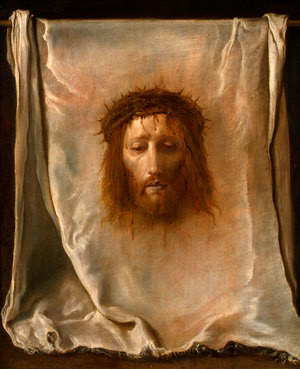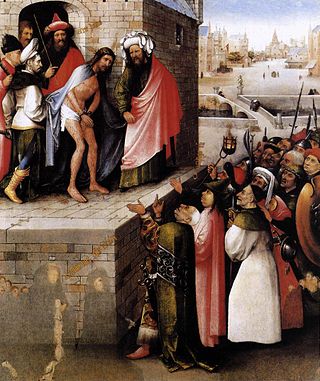" Ecce homo " (Latin: "Behold the Man"), is a phrase traditionally attributed to Pontius Pilate at the trial of Jesus.
Contents
Ecce Homo may also refer to:
" Ecce homo " (Latin: "Behold the Man"), is a phrase traditionally attributed to Pontius Pilate at the trial of Jesus.
Ecce Homo may also refer to:

The Museo del Prado, officially known as Museo Nacional del Prado, is the main Spanish national art museum, located in central Madrid. It houses collections of European art, dating from the 12th century to the early 20th century, based on the former Spanish royal collection, and the single best collection of Spanish art. Founded as a museum of paintings and sculpture in 1819, it also contains important collections of other types of works. The numerous works by Francisco Goya, the single most extensively represented artist, as well as by Hieronymus Bosch, El Greco, Peter Paul Rubens, Titian, and Diego Velázquez, are some of the highlights of the collection. Velázquez and his keen eye and sensibility were also responsible for bringing much of the museum's fine collection of Italian masters to Spain, now one of the largest outside of Italy.

Antonello da Messina, properly Antonello di Giovanni di Antonio, but also called Antonello degli Antoni and Anglicized as Anthony of Messina, was an Italian painter from Messina, active during the Italian Early Renaissance.

Renaissance art is the painting, sculpture, and decorative arts of the period of European history known as the Renaissance, which emerged as a distinct style in Italy in about AD 1400, in parallel with developments which occurred in philosophy, literature, music, science, and technology. Renaissance art took as its foundation the art of Classical antiquity, perceived as the noblest of ancient traditions, but transformed that tradition by absorbing recent developments in the art of Northern Europe and by applying contemporary scientific knowledge. Along with Renaissance humanist philosophy, it spread throughout Europe, affecting both artists and their patrons with the development of new techniques and new artistic sensibilities. For art historians, Renaissance art marks the transition of Europe from the medieval period to the Early Modern age.

The Galleria Borghese is an art gallery in Rome, Italy, housed in the former Villa Borghese Pinciana. At the outset, the gallery building was integrated with its gardens, but nowadays the Villa Borghese gardens are considered a separate tourist attraction. The Galleria Borghese houses a substantial part of the Borghese Collection of paintings, sculpture and antiquities, begun by Cardinal Scipione Borghese, the nephew of Pope Paul V. The building was constructed by the architect Flaminio Ponzio, developing sketches by Scipione Borghese himself, who used it as a villa suburbana, a country villa at the edge of Rome.
Andrea Solari (1460–1524) was an Italian Renaissance painter of the Milanese school. He was initially named Andre del Gobbo, but more confusingly as Andrea del Bartolo a name shared with two other Italian painters, the 14th-century Siennese Andrea di Bartolo, and the 15th-century Florentine Andrea di Bartolo.

Ecce homo are the Latin words used by Pontius Pilate in the Vulgate translation of the Gospel of John, when he presents a scourged Jesus, bound and crowned with thorns, to a hostile crowd shortly before his crucifixion. The original New Testament Greek: "ἰδοὺ ὁ ἄνθρωπος", romanized: "idoù ho ánthropos", is rendered by most English Bible translations, e.g. the Douay-Rheims Bible and the King James Version, as "behold the man". The scene has been widely depicted in Christian art.

Ecce Homo is a painting of the moment known as Ecce Homo from the Passion of Jesus by the Italian Baroque master Caravaggio. It is now in the Palazzo Bianco, Genoa, Italy. Contemporary accounts claim the piece was part of an unannounced competition between three artists, and that the Caravaggio version was eventually sent to Spain.

The Crowning with Thorns was the subject of two paintings by the Italian master Caravaggio. The first version, dated to around 1604–1605, is now in the Cassa di Risparmi e Depositi of Palazzo degli Alberti, Prato (Tuscany). The attribution to Caravaggio is disputed.

Andachtsbilder is a German term often used in English in art history for Christian devotional images designed as aids for prayer or contemplation. The images "generally show holy figures extracted from a narrative context to form a highly focused, and often very emotionally powerful, vignette".

Christ at the Column (Pillory) is a small painting by the Italian Renaissance artist Antonello da Messina, executed c. 1476–1478, showing the Flagellation of Christ. It is in the Louvre in Paris.
Crucifixion is an ancient method of execution.

Ecce Homo is a painting of the episode in the Passion of Jesus by the Early Netherlandish painter Hieronymus Bosch, painted between 1475 and 1485. The original version, with a provenance in collections in Ghent, is in the Städel Museum in Frankfurt; a copy is held the Museum of Fine Arts in Boston. The painting takes its title from the Latin words Ecce Homo, "Behold the Man" spoken by the Roman Prefect Pontius Pilate when Jesus is paraded before a baying, angry mob in Jerusalem before he is sentenced to be crucified.

Ecce Homo is a painting by a follower of the Netherlandish painter Hieronymus Bosch. It depicts the presentation of Jesus Christ by Pontius Pilate to the throngs of Jerusalem. Ecce homo is the latin phrase spoken by Pilate, which is where the title comes from. This painting is at the Indianapolis Museum of Art in Indianapolis, Indiana; it is closely similar to one at the Philadelphia Museum of Art.
The Annunciation is the biblical episode of the announcement by the archangel Gabriel to Mary that she would become the mother of Jesus.

Italian Renaissance painting is the painting of the period beginning in the late 13th century and flourishing from the early 15th to late 16th centuries, occurring in the Italian Peninsula, which was at that time divided into many political states, some independent but others controlled by external powers. The painters of Renaissance Italy, although often attached to particular courts and with loyalties to particular towns, nonetheless wandered the length and breadth of Italy, often occupying a diplomatic status and disseminating artistic and philosophical ideas.

This article about the development of themes in Italian Renaissance painting is an extension to the article Italian Renaissance painting, for which it provides additional pictures with commentary. The works encompassed are from Giotto in the early 14th century to Michelangelo's Last Judgement of the 1530s.
Ecce Homo is the title of a series of paintings by the Italian Renaissance master Antonello da Messina. They date from 1470 to 1475.

The Pinacoteca del Castello Sforzesco is an art gallery in the museum complex of the Sforza Castle in Milan, Italy.
Portrait of a Man may refer to:
Judith and Holofernes may refer to: